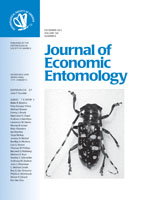In this study, reduced levels of ventilation were applied to small clusters of bees under controlled conditions to determine whether lowered ventilation rates and the resulting increased levels of CO2 could increase the mortality rates of varroa. Two experiments were performed at two different temperatures (10°C and 25°C). Both experiments compared varroa mortality among high (360 liters/h), medium (42.5 liters/h), and low (14 liters/h) rates of ventilation. The clusters of bees (≈300 worker bees) in bioassay cages with 40 introduced varroa mites were placed into self-contained glass chambers and were randomly assigned to one of the three ventilation treatments within incubators set at either of the two temperatures. Bee and varroa mortality and the levels of CO2 concentration were measured in each of the experimental chambers. In both experiments, CO2 levels within the chamber increased, with a decrease in ventilation with CO2 reaching a maximum of 1.2 ± 0.45% at 10°C and 2.13 ± 0.2% at 25°C under low ventilation. At high ventilation rates, CO2 concentration in chamber air was similar at 10°C (1.1 ± 1.5%) and 25°C (1.9 ± 1.1%). Both humidity and CO2 concentration were higher at 25°C than at 10°C. Bee mortality was similar within all ventilation rate treatments at either 10°C (11.5 ± 2.7–19.3 ± 3.8%) or 25°C (15.2 ± 1.9–20.7 ± 3.5%). At 10°C, varroa mortality (percentage dead) was greatest in the high ventilation treatment (12.2 ± 2.1%), but only slightly higher than under low (3.7 ± 1.7%) and medium ventilation (4.9 ± 1.6%). At 25°C, varroa mortality was greatest under low ventilation at 46.12 ± 7.7% and significantly greater than at either medium (29.7 ± 7.4%) or low ventilation (9.5 ± 1.6.1%). This study demonstrates that at 25°C, restricted ventilation, resulting in high levels of CO2 in the surrounding environment of small clusters of honey bees, has the potential to substantially increase varroa mortality.
How to translate text using browser tools
1 December 2011
Laboratory Study on the Effects of Temperature and Three Ventilation Rates on Infestations of Varroa destructor in Clusters of Honey Bees (Hymenoptera: Apidae)
Paul R. Kozak,
Robert W. Currie
ACCESS THE FULL ARTICLE
It is not available for individual sale.
This article is only available to subscribers.
It is not available for individual sale.
It is not available for individual sale.
carbon dioxide
environment
modified atmosphere
mortality
Varroa destructor





